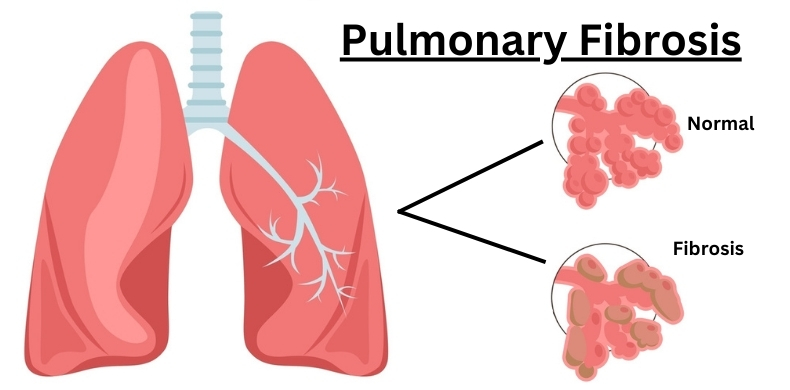
Nowadays, our lungs face many challenges in our lives due to various complicated reasons, such as unhealthy food, air pollution or having any bad habit like smoking. But if a person ignores any of the rising symptoms, it can transform into severe diseases such as pulmonary fibrosis. This is a condition which directly show impacts in lungs and causes scarring and stiffness in the lung tissue. This condition is the main reason behind the difficulty as it hinders oxygen passage into the bloodstream, causing various symptoms. That’s why it is important to understand this condition for better intervention, and with the help of this blog, you can get the proper information through seven major aspects which might help a person understand pulmonary fibrosis and get the right treatment at the appropriate time.
7 Key Facts About Pulmonary Fibrosis
1. Understanding Pulmonary Fibrosis
Pulmonary fibrosis, an interstitial lung disease, entails continued scarring of lung tissue, affecting breathing and respiratory function progressively. The scarring thickens tissue around and between lung air sacs (alveoli), hampering oxygen flow into the bloodstream, complicating breathing. As time passes, lung tissue stiffens, and causing a gradual decline in breathing ability and worsening respiratory function over time. Pulmonary fibrosis may result from known factors like environmental exposure or medications, or it can be idiopathic, termed idiopathic pulmonary fibrosis (IPF).
2. Symptoms of Pulmonary Fibrosis
The symptoms of pulmonary fibrosis often develop gradually and can vary significantly from person to person. Common symptoms include:
- Breathing feels short and shallow.
- Persistent dry cough lingers on.
- Extreme tiredness despite sufficient rest.
- Breathlessness, worsened by physical activity.
- Unexplained weight loss occurs.
As the disease worsens, an individual might notice:
- Fingertips or toes become clubbed.
- Skin goes bluish because it doesn’t receive enough air.
Recognizing these symptoms early and seeking medical advice can lead to an earlier diagnosis and potentially better outcomes.
3. Diagnosis of Pulmonary Fibrosis Disease
Diagnosing pulmonary fibrosis can be challenging because its symptoms overlap with those of many other lung conditions. The process typically involves several steps:
- Medical history and physical exam: Your doctor will review your symptoms and exposure history.
- Imaging tests: High-resolution computed tomography (HRCT) scans are crucial for detecting lung scarring.
- Lung function tests: These assess how well your lungs are working.
- Biopsy: For some cases, a lung biopsy is needed to confirm the diagnosis.
- Blood tests: These can help rule out other conditions and identify markers associated with pulmonary fibrosis.
4. Treatment Options for Pulmonary Fibrosis
Though no cure exists for pulmonary fibrosis once lung damage occurs, but early diagnosis and treatment aim to manage symptoms and slow progression. Key treatment options include:
- Medications: Anti-fibrotic drugs such as pirfenidone and nintedanib can slow the progression of the disease.
- Oxygen therapy: This can help maintain oxygen levels in your blood and make breathing easier.
- Pulmonary rehabilitation: A program of exercise, education, and support can improve your ability to manage symptoms.
- Lung transplant: In severe cases, a lung transplant might be considered as a treatment option.
5. Lifestyle Changes
Adapting to life with pulmonary fibrosis often entails significant lifestyle adjustments. Here are some essential strategies to help reduce the chances of avoiding pulmonary fibrosis:
- Quit smoking: Smoking exacerbates lung damage and should be avoided.
- Avoid lung irritants: Steer clear of environmental pollutants, dust, and chemicals.
- Healthy diet: Eating a balanced diet can help maintain strength and energy.
- Regular exercise: Even with breathing difficulties, gentle exercise can improve overall health and lung function.
- Vaccinations: Stay up-to-date with flu and pneumonia vaccinations to prevent respiratory infections.
6. Coping with Emotional Challenges
Pulmonary fibrosis not only affects your physical health but also takes an emotional toll. The chronic nature of the disease often leads patients to experience anxiety, depression, and stress as common emotional challenges. Here are some ways to cope:
- Support groups: Joining a support group can provide emotional comfort and practical advice from others facing similar challenges.
- Counseling: Professional counseling or therapy can help manage mental health issues.
- Mindfulness and relaxation techniques: Engaging in practices like meditation, yoga, and deep breathing can alleviate stress and enhance emotional well-being significantly.
7. Staying Informed: The Importance of Education and Advocacy
Staying informed about pulmonary fibrosis is crucial for managing the disease effectively. Regularly update yourself with information from reliable sources, such as:
- Medical journals and websites: Trustworthy sites like those of the American Lung Association or Pulmonary Fibrosis Foundation offer valuable resources.
- Health care providers: Regular consultations with a good pulmonolgist, such as Prof. Dr. Syed Arshad Husain can keep you updated on new treatments and research.
- Clinical trials: Taking part in clinical trials offers access to innovative treatments while contributing to advancing medical knowledge and treatment options.
Conclusion
Hope this blog provides complete information about pulmonary fibrosis, and now it’s easy for you to understand what exactly pulmonary fibrosis is. And how does it start developing and making an individual’s life difficult? Actually, pulmonary fibrosis is a really serious condition and requires good intervention from the best pulmonologist in Dubai, such as Prof. Dr. Syed Arshad Husain. And they can help you overcome this severe condition.

